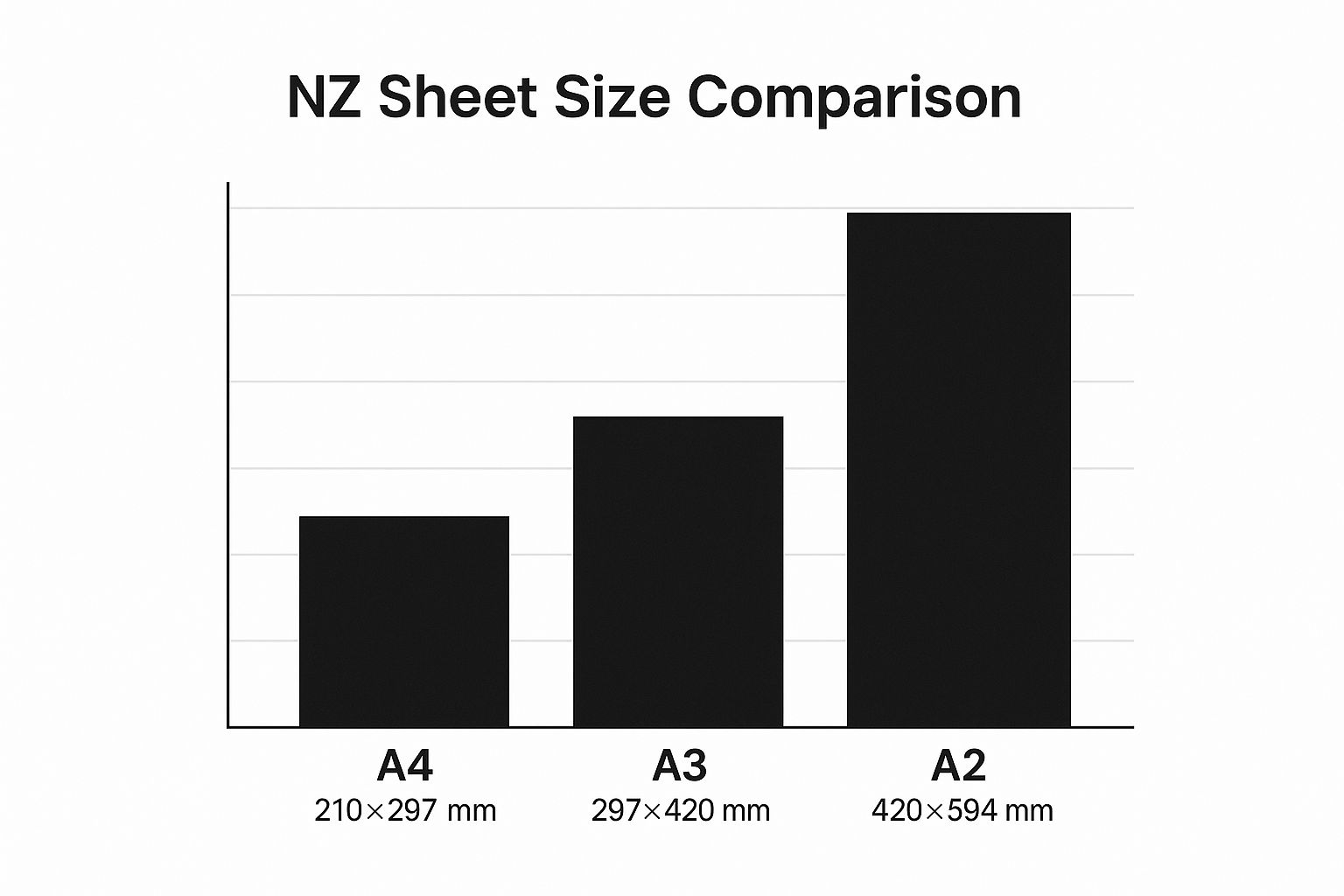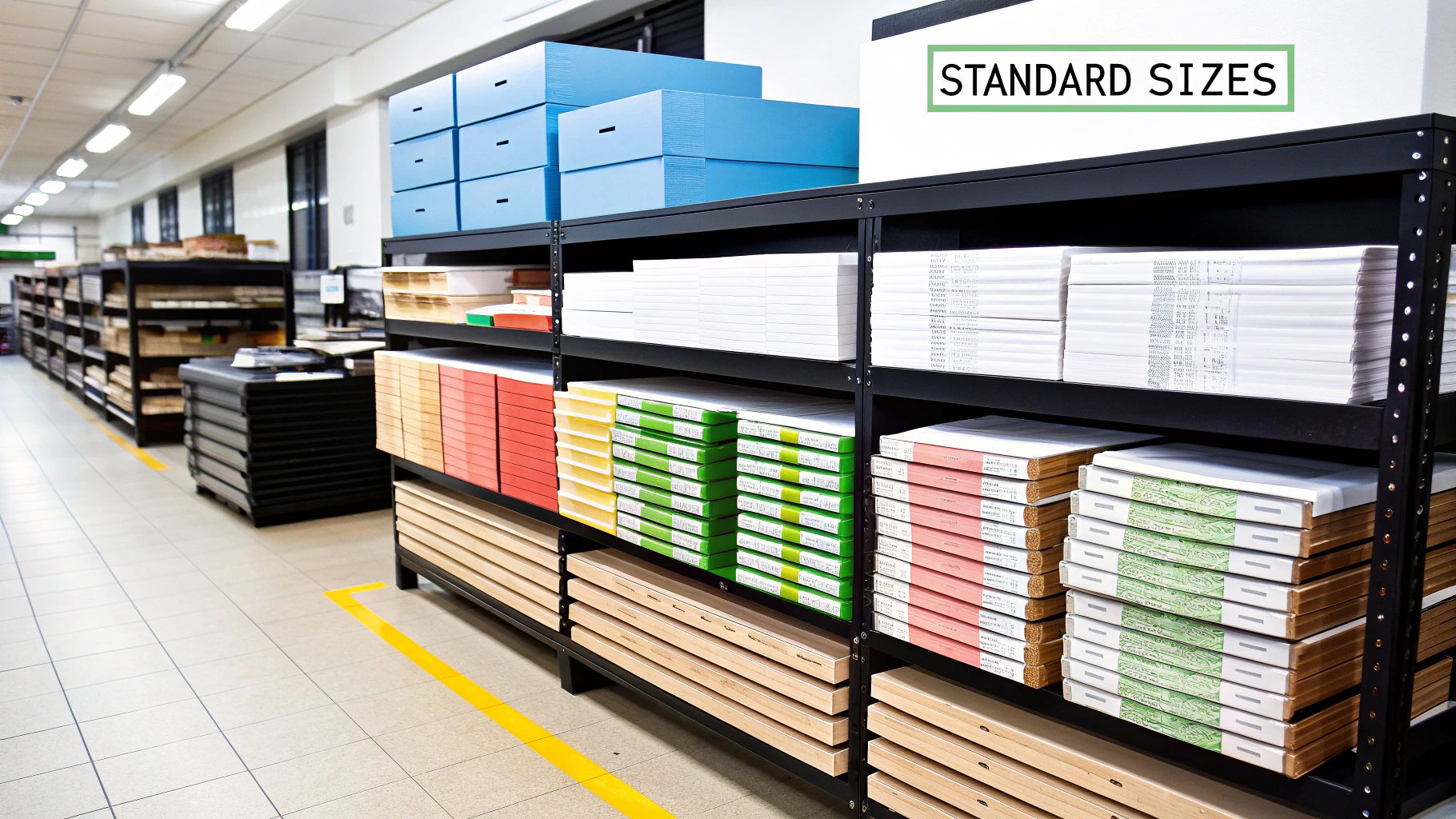Getting the right sheet sizes in NZ can feel like a guessing game, but it all comes down to a simple truth: New Zealand has its own standard bed dimensions. These aren't the same as what you might find in the US or the UK. Kiwi bed sizes—from Single all the way up to Californian King—have very specific measurements, and knowing them is the secret to a perfect fit.
Finding Your Fit: A Quick Guide to NZ Sheet Sizes
Shopping for new sheets should be one of life's little luxuries, not a frustrating chore. We’ve all been there—you buy a beautiful set of sheets, get them home, and discover they’re either too tight to wrestle onto the mattress corners or so loose they bunch up into a tangled mess by morning. This almost always happens because of a mismatch between the sheet size and your actual bed dimensions.
Consider this your ultimate cheat sheet for navigating sheet sizes in NZ. We're here to clear up the confusion around the numbers so you can confidently pick linens that look and feel just right. Think of it as the blueprint for a perfectly made bed, every single time.
Understanding the Standards
The New Zealand bedding industry follows a distinct set of measurements. While names like 'Queen' or 'King' are used globally, the centimetre dimensions can be surprisingly different from one country to another. The first, most critical step is to identify the specific NZ standard that matches your bed.
Key Insight: The most common mistake people make is assuming a 'King' size is the same everywhere. An NZ King is not the same as an Australian King or a UK King. That’s why you should always rely on the actual dimensions, not just the name, to get it right.
This quick reference table breaks down every standard size, giving you a clear, side-by-side comparison. Just like the image below shows how different paper sizes scale up, bed and sheet sizes are designed to fit progressively larger mattresses.

This principle of scaling ensures a consistent and appropriate fit as you move from one size to the next.
Standard New Zealand Bed and Sheet Dimensions
To take all the guesswork out of the equation, here is a comprehensive table detailing standard NZ mattress dimensions and the ideal corresponding sizes for both fitted and flat sheets.
A fitted sheet is designed to wrap snugly around your mattress, while a flat sheet needs enough extra fabric to provide a generous drape over the sides and foot of your bed.
| Bed Size | Mattress Dimensions (cm) | Fitted Sheet Size (cm) | Flat Sheet Size (cm) |
|---|---|---|---|
| Single | 92 x 188 | 92 x 190 + 40 | 180 x 250 |
| King Single | 107 x 203 | 107 x 203 + 40 | 200 x 260 |
| Double | 138 x 188 | 138 x 190 + 40 | 230 x 250 |
| Queen | 153 x 203 | 153 x 203 + 45 | 245 x 260 |
| King | 168 x 203 | 168 x 203 + 45 | 265 x 260 |
| Super King | 183 x 203 | 183 x 203 + 45 | 280 x 260 |
| Californian King | 203 x 203 | 203 x 203 + 45 | 300 x 280 |
Keep this chart handy when you’re shopping. It's the simplest way to ensure you always bring home sheets that fit your bed beautifully.
How to Measure Your Mattress for a Perfect Fit

Knowing the standard sheet sizes NZ uses is a great start, but it's really only half the story. Think of it like buying a pair of jeans. Just knowing your waist size isn’t enough; the inseam, the cut, and the rise all matter. It’s the same with mattresses. Not all "Queen" beds are created equal, especially when it comes to their thickness.
Today’s mattresses, with their plush pillow tops and built-in comfort layers, can vary quite a bit in height. This single measurement is almost always the culprit behind ill-fitting sheets. It’s what causes that dreaded corner-pop at 2 AM or leaves you with a loose, baggy fit that never looks tidy. Taking a moment to measure your own mattress is the secret to getting that perfectly snug, hotel-quality finish.
The Three Essential Measurements
To make sure your new sheets fit like they were custom-made, you just need three key numbers. So, grab a tape measure, strip the bed, and let’s get it done. You'll get the truest numbers from a bare mattress.
- Width: Measure from the left edge to the right edge at the widest part of the mattress.
- Length: Measure from the head of the bed right down to the foot.
- Depth (or Height): This one is the most important. Measure from the bottom seam of the mattress to the very top. If you have a pillow top, make sure you measure to its highest point, not just the side seam.
With these three numbers in hand, you’ll have a complete picture of what you’re working with and can shop with total confidence.
Why Mattress Depth is the Game-Changer
Let's put it another way. Imagine you've bought a frame for a beautiful painting. The length and width are perfect, but the frame is too shallow for the thick, textured canvas. It just won’t sit right. A fitted sheet works on the same principle.
The length and width measurements confirm you have a standard NZ size, like a King or a Super King. But the depth is what dictates the "pocket size" you need in a fitted sheet. A standard sheet might be designed for a mattress depth of 30-40 cm. If your wonderfully plush mattress is 45 cm deep, that standard sheet simply won’t have enough fabric to tuck securely underneath.
The Golden Rule of Fit: Your fitted sheet's pocket depth should be at least 5-8 cm deeper than your mattress. This gives you plenty of extra fabric for the elastic to wrap fully under the mattress, creating a tight, secure grip that stays put.
A Step-by-Step Guide to Measuring Depth
Getting an accurate depth measurement can be a bit tricky, especially on a softer mattress that crowns in the middle. Here’s a foolproof method to get it right:
- Step 1: Lay a long, flat object like a hardcover book or a ruler across the corner of your mattress so it hangs slightly over the side.
- Step 2: Use your tape measure to measure from the bottom edge of the mattress straight up to the bottom of the flat object.
- Step 3: Jot that number down. That’s your true mattress depth.
Once you’re armed with these precise measurements, you can shop for new bedding without any guesswork. For a deeper dive into different materials and weaves, have a look at our guide on how to choose the right sheet set for your bed size in NZ. This simple act of measuring is the best way to ensure your investment in beautiful linens pays off with a flawless fit.
Decoding Bedding Jargon Beyond Thread Count
 Stepping into the world of luxury linens can feel a bit like learning a new language. You're suddenly faced with terms like thread count, percale, sateen, and long-staple cotton, all thrown around as the last word in quality. But what do they actually mean for how your sheets feel against your skin?
Stepping into the world of luxury linens can feel a bit like learning a new language. You're suddenly faced with terms like thread count, percale, sateen, and long-staple cotton, all thrown around as the last word in quality. But what do they actually mean for how your sheets feel against your skin?
For a long time, the loudest marketing message has been "high thread count," but frankly, it’s not the whole story. It can even be a bit misleading. The real secret to luxurious, long-lasting bedding lies in a blend of three things: the quality of the fibre, the type of weave, and, yes, a sensible thread count.
Getting your head around these elements helps you see past the sales hype. It gives you the power to choose sheets that perfectly match how you like to sleep, whether you're after that crisp, cool feel of a boutique hotel bed, the silky drape of a five-star suite, or the breathable comfort of natural linen.
The Myth of Thread Count
The bedding industry has spent years pushing a very simple story: the higher the thread count, the better the sheets. This number is just a measure of the threads woven into one square inch of fabric. The problem is, those incredibly high counts—we're talking 800 or 1000—are often a bit of a cheat, achieved by twisting multiple, lower-quality yarns together to inflate the number.
This trickery can create a fabric that's dense, heavy, and doesn't breathe well, which is the exact opposite of what most of us want in our bed. A much smarter approach is to look for sheets made from high-quality, single-ply yarns. Here, a thread count between 300 and 500 usually hits that sweet spot of softness, strength, and breathability. For a deeper dive, our guide on what is the best thread count for sheets has all the details.
Expert Takeaway: Don't get fixated on thread count. The quality of the fibre and the type of weave are far better indicators of how a sheet will feel and how long it will last. A 400-thread-count sheet made from premium Supima® cotton will feel worlds better and outlast a 1000-thread-count sheet made from cheap, multi-ply yarns.
Weave Wars: Percale vs. Sateen
The weave is all about how the threads are interlaced, and it has the single biggest impact on the texture and feel of your sheets. The two most common weaves for cotton are percale and sateen. It helps to think of them as two different recipes that start with the same basic ingredient.
-
Cotton Percale: This is your classic grid pattern—a simple one-thread-over, one-thread-under weave. The result is a light, crisp, and incredibly breathable fabric with a clean, matte finish. If you love that freshly laundered, hotel-style feeling, percale is your perfect match. It's especially brilliant for anyone who tends to sleep hot.
-
Cotton Sateen: This weave is a little more complex, using a one-thread-under, three-or-four-threads-over pattern. This method puts more threads on the surface, creating a silkier, smoother feel with a lovely, subtle sheen. Sateen sheets drape beautifully, feel exceptionally soft, and are also more resistant to wrinkles than percale.
Beyond Cotton: The Appeal of Linen
Of course, the story doesn't end with cotton. There's also linen—a timeless choice loved for its unique natural texture and amazing breathability. Made from the fibres of the flax plant, linen sheets have a more relaxed, earthy character.
Linen is famously durable and has the wonderful quality of getting softer and softer with every wash. Its natural moisture-wicking ability makes it perfect for year-round comfort, keeping you cool on hot summer nights and cosy in the winter. If you lean towards a lived-in, effortless style and want maximum airflow, linen is a fantastic choice.
What About International and Non-Standard Bed Sizes?
Have you ever bought beautiful bedding from an overseas shop, only to bring it home and find it just doesn't sit right on your NZ bed? It's a surprisingly common problem. You’d think a 'Queen' is a 'Queen' no matter where you are, but the reality is that the actual dimensions can be quite different from country to country.
When you're shopping internationally or you've bought an imported bed frame, you need to put on your detective hat. The secret is to completely ignore the name on the label—like 'King' or 'Queen'—and look only at the measurements in centimetres. Australian, UK, and US sizes all march to the beat of their own drum, and they rarely line up perfectly with the sheet sizes NZ uses. That small discrepancy is all it takes to go from a snug fit to a rumpled mess.
NZ vs International Bed Size Comparison
Let's break down exactly how these sizes differ. You might be surprised by how a few centimetres can change everything.
Here's a quick comparison to show you what I mean. Notice how the names can be misleading, especially between the UK and NZ.
| Size Name | NZ Dimensions (cm) | Australian Dimensions (cm) | UK Dimensions (cm) | Notes on Fit |
|---|---|---|---|---|
| Queen | 153 x 203 | 153 x 203 | (No direct equivalent) | NZ and AU Queens are identical. A UK 'King' (150x200) is the closest but will be a very tight fit. |
| King | 168 x 203 | 183 x 203 | 150 x 200 | An AU King is much wider. A UK King is significantly smaller than an NZ King. |
| Super King | 183 x 203 | (No direct equivalent) | 180 x 200 | An NZ Super King is the same size as an Australian King. A UK Super King is slightly narrower and shorter. |
As you can see, relying on the name alone is a recipe for disappointment. Always, always check the numbers.
These differences aren't just random; they’re often tied to local manufacturing standards. The health of New Zealand's own manufacturing sector, tracked by things like the Performance of Manufacturing Index (PMI), can influence the variety of sheet sizes available locally. The industry has its ups and downs, which can impact everything from material supply to the production of both standard and less common sizes. You can get a deeper insight into these economic drivers in the Manufacturing Perspectives report.
Making It Work: Practical Tips for Shoppers
So, what can you do if you fall in love with a set of sheets that isn't quite the right size? Don't despair! You've got a few clever workarounds.
-
Size Up the Flat Sheet: This is the easiest trick in the book. Let's say you have an NZ King bed (168 cm wide) and find an amazing Australian King sheet set (183 cm wide). The flat sheet and pillowcases will work beautifully. That extra fabric on the flat sheet just gives you a more generous, luxurious drape over the sides of the bed.
-
Check the Fitted Sheet Depth: The fitted sheet is where things get tricky. An Australian King fitted sheet will be too baggy on a standard NZ King mattress. But, you might get lucky. If your mattress is particularly deep, that extra mattress height could take up the slack from the sheet's extra width. Always check the "pocket depth" measurement listed on the packaging.
-
Consider Custom Options: For one-of-a-kind or imported beds, sometimes getting sheets custom-made is the only way to guarantee a perfect fit. It might feel like a bigger investment at first, but the flawless, hotel-quality finish is often well worth it.
Pro Tip: Never assume international sizes are interchangeable. An Australian King is wider than an NZ King, but an NZ Super King is wider than an Australian King. Keeping a note of your mattress dimensions on your phone makes checking sizes on the go much easier.
Handling Less Common NZ Sizes
It's not just international differences that can catch you out. Right here in New Zealand, you might come across less common sizes like the Long Single or the massive Californian King. These almost always need special-order bedding.
-
Long Single (92 x 203 cm): You’ll often find these in adjustable bed setups or used as a pair to create a Split King. You'll need to find a retailer that specifically stocks sheets for this longer, narrower dimension.
-
Californian King (203 x 203 cm): A true square, this bed is the definition of spacious. It absolutely requires its own dedicated sheets, as a standard Super King set will be too narrow and short.
By becoming a savvy shopper who focuses on measurements, you can buy bedding from anywhere with confidence. You’ll be sure that your bed not only looks fantastic but feels just right, every single night.
How to Care for Your Sheets to Ensure Longevity

You’ve invested in beautiful, high-quality bedding, and that’s a brilliant first step. But making that investment last comes down to how you care for it. Getting years of enjoyment from your linens isn’t about luck; it’s about proper washing, drying, and storage. These simple habits are what preserve that incredible softness and vibrant colour.
It’s really about more than just chucking them in the wash. With a little know-how, you can protect the delicate fibres from damage, stop colours from fading, and keep that just-bought feeling alive for years. Let’s walk through the best ways to keep your sheets in pristine condition.
The Ideal Washing Routine
The foundation of great linen care is built in the laundry room. A few simple rules can make all the difference, protecting your sheets from the kind of wear and tear that ages them prematurely.
First up, always wash your sheets by themselves. Never mix them with towels or clothes, especially anything with zips or buttons. Those heavier items can be quite abrasive, causing pilling and snagging on the finer fibres of your sheets.
Next, think about your water temperature. While it's tempting to blast everything on hot for hygiene, a warm or cold wash is so much gentler on most fabrics. This is especially true for natural fibres like cotton and linen. A cooler wash helps prevent shrinkage and keeps the dyes looking bright and fresh.
And finally, don’t overload the machine. Your sheets need room to swish around freely to get properly clean. Giving them space also prevents intense wrinkling and puts less strain on the seams.
Important Tip: It’s best to avoid liquid fabric softeners. They often work by coating fibres with a chemical film, which sounds good but actually reduces the fabric's natural breathability. Over time, this can make your sheets feel less comfortable and trap moisture.
Drying and Storing for Success
How you dry and store your sheets is every bit as important as how you wash them. The key is to be as gentle as possible to maintain their structure and softness.
When it comes to drying, nothing beats line-drying in the shade. The fresh air leaves them smelling incredible, and keeping them out of direct sunlight stops the colours from fading. If you need to use a machine, always choose a low heat, gentle cycle. High heat is the number one enemy of fine linens; it can cook the fibres, making them brittle and weak.
Here are a few extra tips for better drying:
- Try Wool Dryer Balls: These are a fantastic, natural alternative to dryer sheets. They help soften fabrics, cut down on static, and can even speed up drying time by improving airflow.
- Remove Them Promptly: Don't let your sheets sit in the dryer after the cycle ends. Taking them out right away is the best way to minimise wrinkles.
- Fold with Care: A neatly folded sheet is a happy sheet. To keep your linen cupboard perfectly organised, try storing each set inside one of its matching pillowcases.
If you're working with premium materials and want more specific advice, our guide on how to care for pure Egyptian cotton has even more detailed tips.
Common Questions About NZ Sheet Sizes
Even with all the charts and guides in the world, a few practical questions always seem to pop up when you’re actually ready to buy new bedding. Let's be honest, navigating the world of sheet sizes in NZ can feel a bit tricky, especially when you're dealing with things like an imported bed or just your own personal sleeping habits.
So, let's tackle some of the most common queries I hear all the time. These are the real-world problems that can trip up even the most careful shoppers. Getting them sorted now means you’ll walk away with linens you’ll absolutely love for years to come.
Will Australian Sheets Fit My NZ Bed?
This is probably the question I get asked most, and the answer is a classic "it depends." While some sizes line up perfectly, others are just different enough to be a real headache. It’s a common trap, especially when shopping online.
- Identical Matches: An Australian Queen bed (153 x 203 cm) is the exact same size as our NZ Queen. So, in this case, any Aussie Queen sheet set will fit your NZ Queen bed like a glove.
- The King Confusion: Here’s where it gets tricky. An Australian King (183 x 203 cm) is actually the same size as an NZ Super King. It is not the same as an NZ King (168 x 203 cm). If you buy an Aussie King set for your NZ King bed, that fitted sheet will be far too wide and baggy.
- The Super King Swap: On the flip side, because an NZ Super King (183 x 203 cm) matches an Australian King, you can often buy Australian King sheets for your NZ Super King bed without any issues at all.
The golden rule here? Always ignore the name on the packet—King, Super King, whatever—and compare the centimetre dimensions directly to your own mattress measurements.
What Is the Most Important Measurement for a Fitted Sheet?
Hands down, the single most critical measurement for a fitted sheet is its depth, sometimes called the pocket depth. This is what determines whether the sheet will hug your mattress corners securely or frustratingly pop off in the middle of the night. We've all been there.
Many standard fitted sheets are made for mattresses up to about 35 cm deep. But with plush pillow tops and extra comfort layers becoming so popular, a lot of modern mattresses are much taller, often reaching 40-50 cm.
Key Takeaway: Putting a standard fitted sheet on a deep mattress is like trying to put a small lid on a large pot—it simply won't cover it properly. If your mattress is over 40 cm tall, always look for sheets labelled "deep pocket" or "extra deep." A good fit means the elasticated edge can tuck a good 5-8 cm right underneath the mattress.
Do I Really Need a Flat Sheet?
Ah, the great flat sheet debate! This question often sparks some strong opinions, and honestly, there’s no right or wrong answer. It’s all about personal preference.
Traditionally, a flat sheet (or top sheet) serves a really practical purpose. It acts as a hygienic barrier between you and your more expensive duvet or quilt. This means you only need to wash the flat sheet weekly, while your bulkier duvet cover might only need a wash every few weeks, which can really help extend the life of your duvet.
However, many Kiwis are now embracing the minimalist, European-style approach. They prefer a high-quality duvet with a washable cover and skip the flat sheet altogether. It definitely makes bed-making simpler and creates a cleaner, less layered look. The choice is yours, based entirely on what you find most comfortable and convenient.
At The Foxes Den, we believe in finding the perfect fit for your home and lifestyle. Explore our curated collection of luxury Supima® cotton and European linen bedding to create your perfect sanctuary. Discover your ideal sheets today at The Foxes Den.


